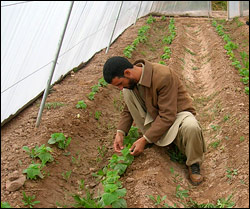Agriculture
At the April, 2009 G20 Summit President Obama called upon Congress to double U.S. support for agricultural development in developing countries to more than $1 billion. Recognizing that solving to food insecurity requires engaging the world’s poorest populations toward rapid, sustained economic growth, the President tasked USAID to take a leading role in the endeavor. (For details, see the White House fact sheet.)
 |
| USAID supported greenhouses allow farmers in Afganistan like Mola Shah Goel to grow fruits and vegetables for sale year round. |
|
The recent food price crisis and global recession added to the suffering of people living in poverty and chronic hunger. Aound 75% of people in poor countries live in rural areas—the vast majority depend on agriculture for their livlihoods. In many countries where hunger is prevalent, farming is done by women, who own barely two percent of land worldwide, and often have limited access to agriculture inputs, loans, and opportunities to learn about improved techniques.
Agricultural development reduces global hunger and poverty because it is a proven engine of economic growth early in the development process. Throughout history, growth in agriculture was a precursor for industrial growth - from mid-18th century England to late-19th century Japan to modern China whose rural poverty declined from 53 percent in 1981 to 8 percent in 2001. Achieving the first of the United Nation's eight Millennium Development Goals, eradicating extreme poverty and hunger, requires significant investment in agriculture by donors, developing countries, and the private sector. USAID helps developing countries to harness agriculture for economic growth to increase the supply and lower the cost of food and increase incomes by making agriculture more efficient, productive and sustainable.
 USAID’s approach USAID’s approach
USAID has a long history of technical leadership in international agricultural development, drawing upon the expertise of U.S. universities, industry, non-governmental and private voluntary organizations, and multilateral development partners. USAID aligns behind country-driven strategies and invests in strengthening both public and private institutions that underpin growth of the agricultural sector. The Agency works throughout the sector, from developing improved seeds and management practices to strengthening the industries along the agricultural value chain. USAID is scaling-up a comprehensive approach to agriculture by:
Back to Top ^
|




